This post may contain affiliate links. Read more at our disclosure policy.
These Extra Virgin Olive Oil Chocolate Chip Cookies are made with olive oil instead of butter. They have a unique flavor and texture and are sure to delight this holiday season. These cookies are also a great dairy free dessert idea.

I first had olive oil cookies at the Oregon Olive Mill at Red Ridge Farms. They were delicious and had this lovely rich and fresh olive oil flavor with each bite. My thanks go out to Libby Crow for sharing this delicious recipe!
Table of Contents

Which olive oil is best for baking cookies?
If you want that rich, herbaceous olive oil flavor, you should definitely use extra virgin olive oil. ‘What makes EVOO so special?’ you might ask. It all has to do with how it’s made. Extra virgin olive oil is extracted without heat or added chemicals. This makes it ‘unrefined’ and allows it to keep its olive-y smell and flavor.
There are several different varieties of olive which each produce slightly different olive oils.
- For a lighter more delicate flavor try Arbequina olive oil.
- For a bolder taste try Kalamata olive oil.
- Whatever type you prefer, you do not need to use the highest quality oil in these cookies.
Save the expensive stuff for salads and bread dipping and use a medium quality oil for baking and cooking.

Substituting Vegetable Oil or Butter with Olive Oil
This recipe is made specifically for olive oil. However, if you are interested in substituting olive oil in other baked goods you need to do a little math.
- Olive oil can be substituted for canola or vegetable oil 1:1
- Olive oil can be substituted for butter 3:4 (if a recipe calls for 4 Tablespoons of butter use 3 Tablespoons of olive oil)
Since olive oil is a liquid at room temperature, this substitution keeps the balance of wet to dry ingredients. It is important to note that oil is 100% fat whereas butter includes 20% water, which when baked produces steam, a natural leavening agent. Thus, baked goods made with oil will be denser than those made with butter.
Other Substitutions
We used semi sweet chips in this recipe but you can also use dark chocolate or a chopped-up chocolate bar. Try adding chopped nuts. You can also experiment with sprinkling different flavored salts like Espresso Brava Salt on top.
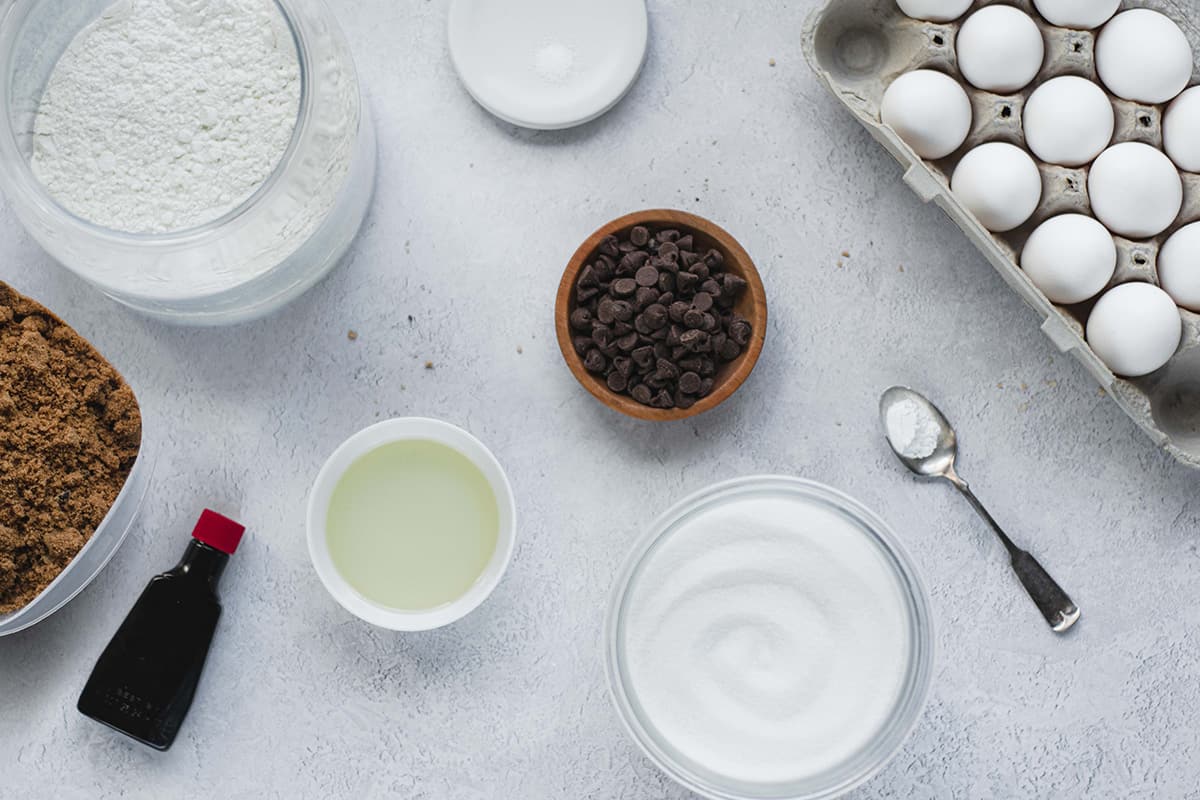
Olive Oil Cookie Ingredients
Olive oil cookies contain many of your standard baking ingredients that you probably already have in your pantry.
- Flour acts as a thickening agent, giving your cookies structure
- Brown and white sugar sweeten the cookies. The extra molasses in dark brown sugar helps keep the cookies soft
- Egg + extra yolk gives richness without needing dairy. Extra beating of the egg acts as a leavening agent and emulsifier
- Salt brings out other flavors and cuts through sweetness
- Baking Soda is the main leavening agent
- Vanilla adds additional flavor depth
- Olive Oil is used instead if butter to add moisture, flavor, and richness
- Chocolate Chips are the best part, right?! We used semi sweet chips but you can also use dark chocolate or a chopped-up chocolate bar.
Would you like to save this?

How to Make Olive Oil Cookies
- Adjust oven rack to middle position and heat oven to 325 degrees. Olive oil has a low smoke point, so we bake these cookies low and slow.
- Whisk flour and baking soda together in medium bowl. This ensures the leavening (baking soda) is properly distributed.
- Add both sugars, salt and vanilla to bowl with Extra Virgin Olive Oil and whisk until fully incorporated.
- Add egg and yolk and whisk until mixture is smooth with no sugar lumps remaining, about 30 seconds. Let mixture stand for 3 minutes, then whisk for 30 seconds. Repeat process of resting and whisking 2 more times until mixture is thick, smooth and shiny. This slow process helps to introduce more air as well as giving the emulsifiers in the egg yolk time to fully incorporate the oil and egg white.
- Using a rubber spatula or wooden spoon, stir in the flour mixture until just combined, about 1 minute. Stir in chocolate chips and nuts (if using), giving the dough a final stir to ensure no flour pockets remain. This dough is drier than a normal (butter) cookie dough. Add the flour slowly, not all at once in case you don’t need the last few tablespoons.
- Using a tablespoon, scoop out as much cookie dough as necessary to make the size of cookies you desire. I did one big tablespoon for each cookie, which equaled to 2-sheets of 12 cookies. Since the oil will not melt like butter, you will need to squish the dough balls into discs with your hands. If the chocolate chips fall out, simply pop them back into the dough.
- (optional) Add a pinch of Espresso Brava Salt or other fleur de sel salts. You can also add more chocolate chips on top.
- Bake cookies 1 tray at a time until cookies are golden brown and still puffy, and edges have begun to set but centers are still soft, 13-15 minutes. Do not over bake.
- Transfer baking sheet to wire rack; and allow cookies to cool.
Leftovers
Olive oil cookies are best consumed within the first 2 days, but can be kept in an air-tight container for 2 weeks.
For more dessert ideas check out our Grill + Smoker Dessert Round-Up.
Pair this amazing cookie with our smoked hot chocolate.

Thank you for being part of our community. If you make any of our dishes we’d love to see them on social media using the hashtag #vindulge and give it a 5 star review.
This post may contain affiliate links. This means if you click on the link, we may receive a small commission if you purchase through the link. We partner with brands we know and love and use and it helps keep the blog going!
This post was originally published in 2014 and updated in 2021 with additional tips and clarity.

Extra Virgin Olive Oil Chocolate Chip Cookies
Ingredients
- 2 cups unbleached all-purpose flour
- ½ teaspoon baking soda
- ½ cup + 1 Tablespoon Extra Virgin Olive Oil
- ½ cup granulated sugar
- 1 cup packed dark brown sugar
- ½ teaspoon table salt
- 2 teaspoons vanilla extract
- 1 large egg
- 1 large egg yolk
- 1½ cups semisweet chocolate chips
- ¾ cup chopped pecans or walnuts,, toasted (optional)
Instructions
- Adjust oven rack to middle position and heat oven to 325 degrees.
- Whisk flour and baking soda together in medium bowl; set aside.
- Add both sugars, salt and vanilla to bowl with Extra Virgin Olive Oil and whisk until fully incorporated.
- Add egg and yolk and whisk until mixture is smooth with no sugar lumps remaining, about 30 seconds. Let mixture stand for 3 minutes, then whisk for 30 seconds. Repeat process of resting and whisking 2 more times until mixture is thick, smooth and shiny.
- Using rubber spatula or wooden spoon, stir in flour mixture until just combined, about 1 minute. Stir in chocolate chips and nuts (if using), giving dough final stir to ensure no flour pockets remain.
- Using a tablespoon, scoop out as much cookie dough as necessary to make the size of cookies you desire. I did one big tablespoon for each cookie, which equaled to 2-sheets of 12 cookies.
- (optional) Add a pinch of Espresso Brava Salt or other fleur de sel salts.
- Bake cookies 1 tray at a time until cookies are golden brown and still puffy, and edges have begun to set but centers are still soft, 13-15 minutes.
- Transfer baking sheet to wire rack; and allow cookies to cool.
Nutrition
Nutrition information is automatically calculated, so should only be used as an approximation.


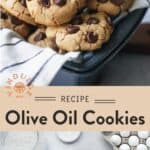


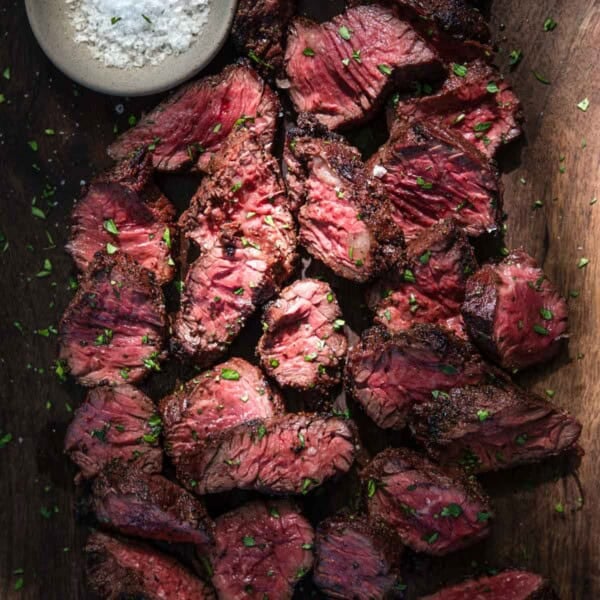

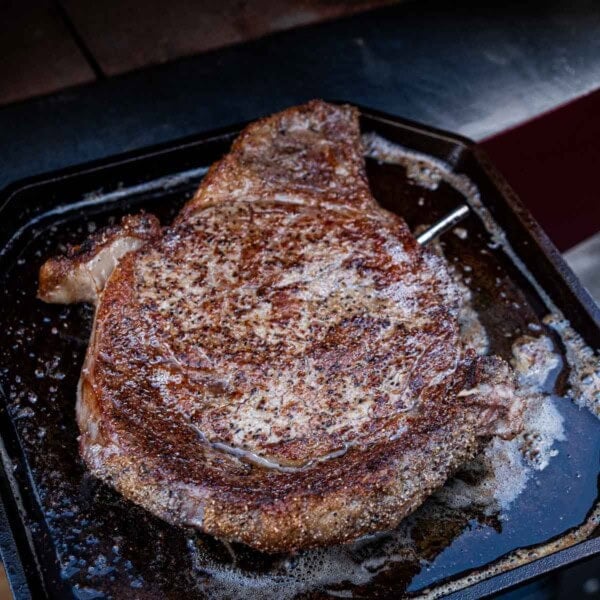
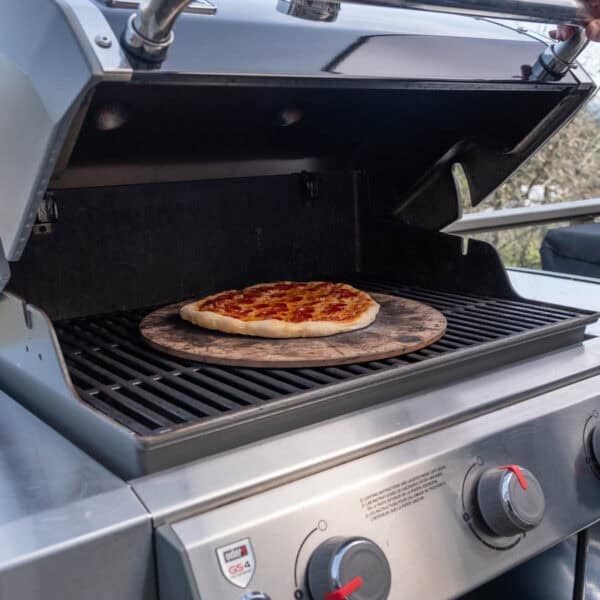

















Hi Mary,I want to make the same types of cookies with millet but I’m not a baker so I don’t know about the recipe or how to customize a recipe according to my need.Please tell me the recipe of millet olive oil cookies with brown sugar.And do I have to grind brown sugar as whole sugar might be crunchy in the cookies.
We haven’t baked with millet flour. I might suggest using a millet cookie recipe as a start for the right ratio of flours and then sub the butter with olive oil. Olive oil is a fat in this recipe.
I was really worried about the dough– it was so oily! I only put 4 cookies in at first because I was certain they weren’t going to come out right… I was wrong! They came out great! When I make them again, I may add a little more flour.
I just had chocolate chip cookies made with olive oil at The Mill, a restaurant in Reggello, Italy. They were fantastic!!
I plan on making this with cannabis infused olive oil, I already know the recipe for these cookies is going to be the best thing I’ve ever utilized on the internet. So for that I thank you.
Oh my that sounds very interesting, would love to hear how they turned out!
Made it today since it was storming outside and its DELICIOUS Nobody in my house is complaing. No butter…. It’s okay the olive oil worked wonders! Wish i could post a pic!!!Thanks so much.
Hello! I have made these several times and each time the batter is quite dry and crumbly. I have to add about a tablespoon of water to make it hold together. Any suggestions on what could I be doing wrong? Thanks in advance!
PS– my family LOVES this recipe. Thank you so much for posting!
Thank you!! I hope to get back to you soon with more feedback. I’m going to try to play around with them again this weekend to see if I can recreate your results to see what could be the issue.
Hi Diana, Thanks so much for the feedback! I’ve made these a several times and have not experienced the crumbliness you’re experiencing. But I did reach out to Libby, who created this recipe, to get her feedback. I’m sure she could offer some insight, since she’s made them dozens of times. My initial thought could be on the actual oil you used. What kind did you use? And how old is it? The properties of olive oil start to break down after a year (that’s why it’s best to consume it within a year). I always have used fresh olive oil when I’ve made them. Or, perhaps you just might need more moisture. If your egg is small it could effect the overall moisture too. So right now (without hearing back from Libby), my recommendation would be to add a little more oil, or more egg (perhaps like you were doing with the water, just a tablespoon of egg or oil at a time), until the dough feels a little more moist. Just work with it with your hands and get a good feel for it.
Also, what are you baking it on? I always use parchment paper and have had good results. But if you look at the comments before you, someone uses silicon and the cookies stuck to the pan.
As soon as I hear back from Libby I’ll give you her feedback too!! I hope this helps for now.
A friend was in Greece and brought me some extra virgin olive oil, aromatized with chocolate, and I used it in these cookies. They were absolutely delicious!
There was only one kind of strange thing that happened with them. I use a silicon mat for baking and I’ve never had anything stick to it. But these cookies did. It took quite some effort to get them off in one piece. Do you maybe have any idea why that happened?
That is very strange. I don’t have a silicon mat so can’t say for sure (I usually use either parchment paper or nothing at all). I also remove the cookies immediately after taking them out from the oven and transfer to a cooling rack (so they don’t continue cooking on the pan). I would guess it had something to do with the sugar, or caramelization, but again not sure. I’m going to ask around and get back to you if I find anything else out. Glad the cookies were delicious though 🙂
I am trying this recipe right now I really hope it works it looks so delicious and divine
Ohh awesome! I hope you loved it!
I made these this weekend exactly as directed and they are AWESOME!!! Thanks so much for the amazing recipe!
Awesome! So glad you tried them. They’re quite delicious. Cheers 🙂
Ooh, I must try these. I can never resist a new chocolate chip cookie recipe…especially one that looks as good as this!
I agree. Any good looking cookie is impossible to resist 😉
Any chocolate chip cookie is any instant winner in my book – these look so delicious and I am definitely craving one to devour right now!
Thanks Thalia! I agree, chocolate chip cookies (any and all types) are just the best!!